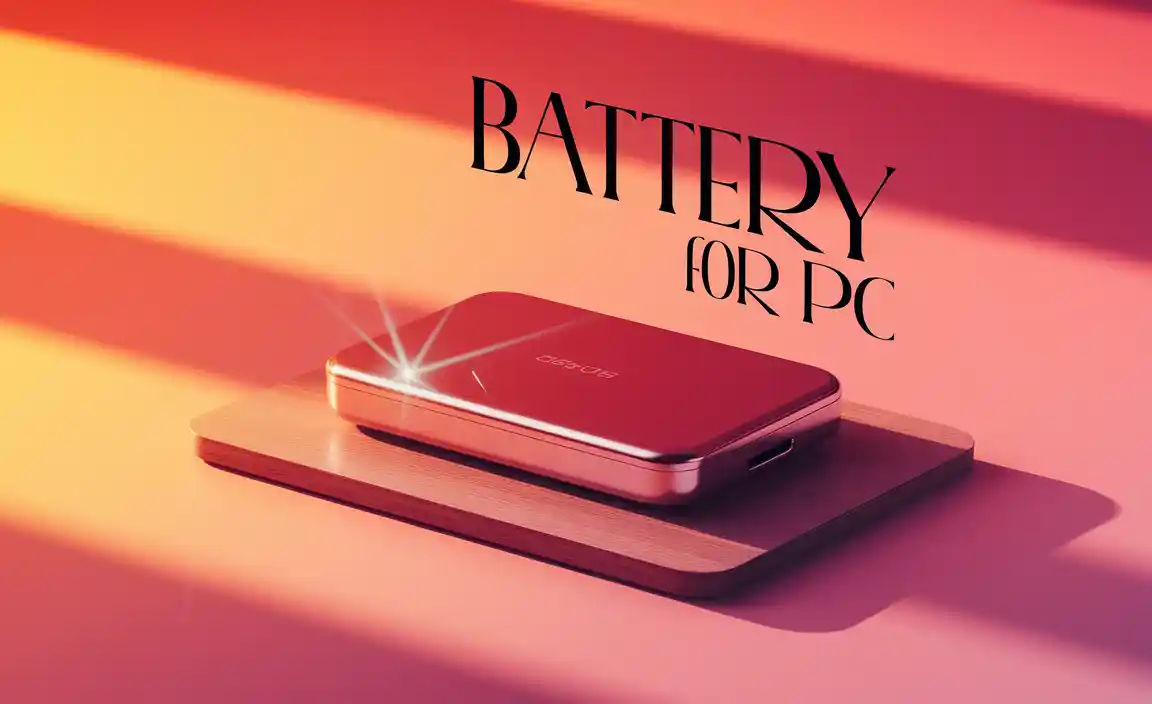Other words for battery? Think power source, energy cell, or energy pack for a quick switch. Finding the right term simplifies discussions about devices, from your car to your phone.
Ever felt stuck trying to describe what powers your gadgets? You might say “battery,” but there are so many other simple ways to talk about them! From the humongous energy source in your car to the tiny cell in your remote control, each one has a job: storing and giving out power. This can get confusing, especially when you’re trying to find the right replacement or just explain something to a friend. But don’t worry, we’re going to explore easy ways to switch up your words so you can talk about power like a pro. Let’s uncover some smart alternatives for “battery”!
Why Knowing “Other Words For Battery” Matters
Being able to call a spade a spade, or in this case, a battery an energy cell, isn’t just about sounding smart. It’s about clear communication, especially when you’re dealing with power sources. Imagine you’re at the auto parts store, and you need a new car battery. If you can ask for an “automotive power unit” or a “vehicle energy storage,” you might get a different, and maybe even better, response from a knowledgeable salesperson. It helps you understand your options better and ensures you get exactly what you need. Plus, using different terms can make technical topics feel less intimidating and more approachable for everyone.
Common Battery Types and Their Jargon
Batteries come in all shapes and sizes, and the words we use often depend on what they power. Let’s break down some common examples:
For Your Car: The Big Kahuna
Your car relies on a hefty battery to start its engine and keep its lights and electronics running. It’s a crucial piece of machinery! When it’s time for a change, you’ll find it under the hood.
- Car Battery: This is the most common term.
- Automotive Battery: A slightly more formal way to say “car battery.”
- Vehicle Power Cell: This highlights its role in powering your vehicle.
- Starter Battery: Emphasizes its primary job of starting the engine.
- 12-Volt Battery: Refers to its standard voltage.
Knowing these can help you when you’re researching replacements or talking to your mechanic. For more on maintaining your car’s power source, check out resources like the U.S. Department of Energy’s tips on battery care.
For Your Phone and Gadgets: The Pocket Powerhouse
These are the batteries that keep our digital lives going. They’re rechargeable and usually built right into our devices.
- Phone Battery: Simple and direct.
- Device Battery: A general term for any gadget.
- Rechargeable Battery: Highlights that it can be powered up again.
- Lithium-ion Cell: The specific technology often used (like Li-ion).
- Power Pack: Often used for external battery banks, but can sometimes refer to internal ones too.
For Portable Power: The On-the-Go Energy
These are your trusty companions when your main device runs out of juice.
- Power Bank: The most popular term for portable chargers.
- Portable Charger: Clearly states its function.
- External Battery: Explains it’s separate from the device.
- Juice Box: A more casual, fun name.
- Energy Reservoir: A more descriptive, technical-sounding alternative.
General Purpose Batteries: The Everyday Helpers
These are the batteries you find in remotes, toys, and other everyday devices.
- AA, AAA, C, D Batteries: Referring to their common sizes.
- Alkaline Battery: The type of battery technology.
- Disposable Battery: Contrasts with rechargeable ones.
- Energy Unit: A more generic term.
- Power Source: Very general, but accurate.
Beyond “Battery”: Synonyms and Related Terms
Let’s dive deeper into the world of synonyms and related terms that can make your conversations about power sources more dynamic and precise. Think of these as tools in your communication toolbox!
Direct Synonyms for “Battery”
These words can often replace “battery” directly in many sentences with little change in meaning. They are great for varying your language and avoiding repetition.
- Power Source: This is a very broad but accurate term. It’s useful when you want to emphasize that something is providing the energy.
- Energy Cell: A common substitute, especially for smaller batteries. It sounds a bit more technical but is still easy to understand.
- Energy Unit: Similar to “energy cell,” this term is good for electronic contexts.
- Power Pack: Often used for larger, portable battery units, but can also refer to the internal battery of a device like a laptop or a portable speaker.
- Electric Cell: A more formal and technical term that precisely describes the basic electrochemical unit that produces electrical energy.
- Voltaic Cell: This is a scientific term named after Alessandro Volta, the inventor of the first battery. It’s less common in everyday speech but accurate.
- Accumulator: This term refers to a device that stores energy, typically electrical energy, for later use. It’s often used in industrial or scientific contexts for larger battery systems.
Descriptive Alternatives Based on Function
Sometimes, the best alternative isn’t a direct synonym but a word or phrase that describes what the battery does. This can be very helpful for beginners.
- Energy Storage Device: This clearly explains the primary function of a battery.
- Power Reservoir: This paints a picture of a place where energy is stored up, ready to be used.
- Charge Holder: Simple, straightforward, and easy to grasp.
- Current Provider: Focuses on the battery’s role in supplying electricity.
- Motive Force Unit: Primarily used when talking about batteries that provide the power to move something, like a car battery providing the force to turn the engine over.
Technological Terms (Use with Care!)
While we want to keep things beginner-friendly, sometimes understanding the technology helps. Use these when you’re a bit more comfortable or talking to someone who knows the jargon.
- Lithium-Ion (Li-ion) Cell: Specific to the most common type of rechargeable battery in phones and laptops.
- Nickel-Metal Hydride (NiMH) Battery: Another common type, often found in older electronics or rechargeable AA/AAA batteries.
- Lead-Acid Battery: The standard type used in most cars.
- Electrochemical Cell: The scientific term for the fundamental component.
When to Use Which Term: A Practical Guide
Choosing the right word depends on who you’re talking to and what you’re talking about. Here’s a simple guide:
Talking to Friends and Family (Casual)
- Phone Battery: Just say “phone battery.”
- Power Bank: “Power bank” or “portable charger” works best.
- Car Battery: “Car battery” is perfectly fine.
- Gadget Battery: “Rechargeable battery” or “the battery for my [device name].”
You can use fun, casual terms like “juice box” for a power bank if the mood is right!
Talking to Tech Enthusiasts or in Online Forums (Slightly More Technical)
- Internal Phone Battery: “Lithium-ion cell” or “Li-ion battery.”
- Portable Charger: “Power bank” is standard.
- Car Battery: “Lead-acid battery” or “12-volt automotive battery.”
- General Battery: “Energy cell,” “power source,” or “rechargeable unit.”
Talking to Professionals (Mechanics, Repair Shops)
- Car Battery: “Automotive battery” or “vehicle battery.” You might also specify CCA (Cold Cranking Amps) or reserve capacity if you know it.
- Laptop Battery: “Laptop power pack” or specifying the model number.
- Anything needing repair: “The energy storage unit for this device.”
When Writing Technical Manuals or Guides
It’s good to be precise but also clear. Use the most accurate term first, then offer simpler alternatives:
- Start with “the vehicle’s battery (also known as an automotive power cell)…”
- For smaller devices, “the internal energy cell (often a lithium-ion battery)…”
Understanding Battery Technology: The Basics
Batteries work by using a chemical reaction to create an electrical current. They have three main parts:
- Anode: The negative electrode.
- Cathode: The positive electrode.
- Electrolyte: A substance that allows ions to move between the anode and cathode.
When the battery is connected to a device (like your phone or car), these ions move through the electrolyte, and electrons flow through the external circuit (your device), creating electricity. For rechargeable batteries, this process can be reversed by supplying an external electrical current, like from a charger.
Car Battery Care: Keeping Your Vehicle Powered
Your car battery is vital. Without it, your car won’t start! Here’s how to keep it in good shape:
Signs Your Car Battery Needs Attention
- Slow engine crank when starting.
- Dim headlights or dashboard lights.
- Clicking sound when you try to start the engine.
- Warning light on the dashboard (often a battery shape).
- Corrosion on the battery terminals (a white or bluish powdery substance).
Simple Maintenance Tips
- Keep Terminals Clean: Gently clean off any corrosion with a wire brush and a mixture of baking soda and water. Make sure the connections are tight.
- Secure the Battery: Ensure your car battery is firmly held in place. A loose battery can be damaged or cause electrical problems.
- Regularly Check Voltage: A simple voltmeter can tell you if your battery is holding a charge. A fully healthy car battery should read around 12.6 volts when the engine is off.
- Avoid Short Trips: Frequent short trips don’t give the alternator time to fully recharge the battery.
- Protect from Extreme Temperatures: Both extreme heat and cold can shorten a battery’s lifespan.
Replacing Your Car Battery
When it’s time for a new one, always get a reputable brand. Safety first!
- Gather Tools: You’ll typically need a wrench (often 10mm or 13mm) to loosen terminal clamps and a socket wrench or adjustable wrench for the battery hold-down bracket.
- Safety Gear: Wear safety glasses and gloves. Batteries contain acid.
- Turn Off Engine & Remove Key: Ensure everything is off.
- Disconnect Negative Terminal First: This is crucial to prevent short circuits. It’s usually marked with a ‘–’ or ‘NEG’.
- Disconnect Positive Terminal: This is usually marked with a ‘+’ or ‘POS’.
- Remove Hold-Down Bracket: This secures the battery in place.
- Lift Out Old Battery: They can be heavy, so lift with your legs.
- Install New Battery: Place the new battery in the tray, ensuring it’s oriented correctly.
- Secure Hold-Down Bracket: Fasten the battery securely.
- Connect Positive Terminal First: Then connect the negative terminal. Ensure connections are snug.
- Start Car: Check if it starts normally.
If you’re not comfortable with this process, a mechanic or auto parts store can often help, sometimes even installing it for you. For detailed instructions and safety, consult your vehicle’s manual or reliable guides from automotive associations.
Phone Battery Life: Extending Your Hours
We rely on our phones constantly, so keeping that battery alive is key. Here are some ways to maximize your phone’s power:
Tips for Better Battery Life
- Lower Screen Brightness: The screen is a major power drain.
- Use Wi-Fi When Available: Wi-Fi typically uses less power than cellular data.
- Enable Battery Saver Mode: Most phones have a mode that reduces background activity and performance to save power.
- Turn Off Unnecessary Notifications: Constant alerts wake up your phone.
- Limit Background App Refresh: Apps refreshing in the background consume power.
- Use Dark Mode: On phones with OLED screens, dark mode can save significant power.
- Disable Location Services for Apps That Don’t Need Them: Location tracking uses a lot of battery.
When Your Phone Battery Needs Replacing
If your phone battery drains very quickly, won’t hold a charge, or causes your phone to shut down unexpectedly, it might be time for a replacement. This is usually best done by a professional repair service to avoid damaging your device.
Power Banks: Your Portable Energy Solution
Power banks, or portable chargers, are lifesavers. They come in various capacities, measured in milliamp-hours (mAh).
Choosing the Right Power Bank
- Capacity: For a quick top-up of a smartphone, 5,000-10,000 mAh is usually sufficient. For multiple charges or larger devices, look for 10,000 mAh or higher.
- Ports: Ensure it has the right type of ports (USB-A, USB-C) for your devices.
- Fast Charging: Look for power banks that support fast charging technologies (like USB Power Delivery or Qualcomm Quick Charge) if your devices do.
Using Your Power Bank Safely
- Charge It Fully: Always start with a full charge.
- Use Good Quality Cables: Cheap, damaged cables can be slow or even dangerous.
- Avoid Extreme Temperatures: Don’t leave your power bank in a hot car or direct sunlight.
- Don’t Overcharge Devices: While most devices have built-in protection, it’s good practice not to leave them charging indefinitely once full.
Frequently Asked Questions (FAQs) about Battery Terms
Q1: What’s the simplest way to say “battery” if I don’t know the exact type?
A: The easiest and most common alternative is “power source.” You can also use “energy cell” for smaller batteries or “power pack” for larger, portable ones.
Q2: Is “energy cell” a good substitute for “battery” when talking about my phone?
A: Yes, “energy cell” is a good and understandable substitute when referring to your phone’s internal battery, especially if you want to sound a little more precise without using jargon.
Q3: What do mechanics mean when they talk about a “12-volt battery” for a car?
A: They are referring to the standard voltage output of most car batteries, which is 12 volts. This is a key specification when buying a replacement.
Q4: Are power banks and portable chargers the same thing?
A: Yes, “power bank” and “portable charger” are interchangeable terms for external devices used to recharge electronics when you’re away from a wall outlet.
Q5: Can I use “accumulator” to describe my phone battery?
A: While technically an accumulator is a device that stores energy, “accumulator” is a more formal or scientific term. For everyday use, “battery” or “energy cell” is much more common and clearer for phone batteries.
Q6: What’s a key safety tip when replacing a car battery?
A: Always disconnect the negative (black, ‘-‘) terminal first before disconnecting the positive (red, ‘+’) terminal. When reconnecting, do the positive first, then the negative.
Q7: Why is it sometimes called a “voltaic cell”?
A: It’s named after Alessandro Volta, who invented the first true battery, the voltaic pile. It’s a scientific term that refers to the fundamental electrochemical unit that generates electricity.
Conclusion: Powering Up Your Conversations
Navigating the world of batteries doesn’t have to be complicated. Whether you’re talking about the robust power source in your car, the trusty energy cell in your phone, or a handy power bank for your adventures, knowing a few alternative terms can make a big difference. Using words like “power source,” “energy cell,” or “power pack” not only keeps your conversations interesting but also helps you understand and articulate your needs more clearly, especially when shopping for replacements or seeking advice. Remember to always prioritize safety, especially




